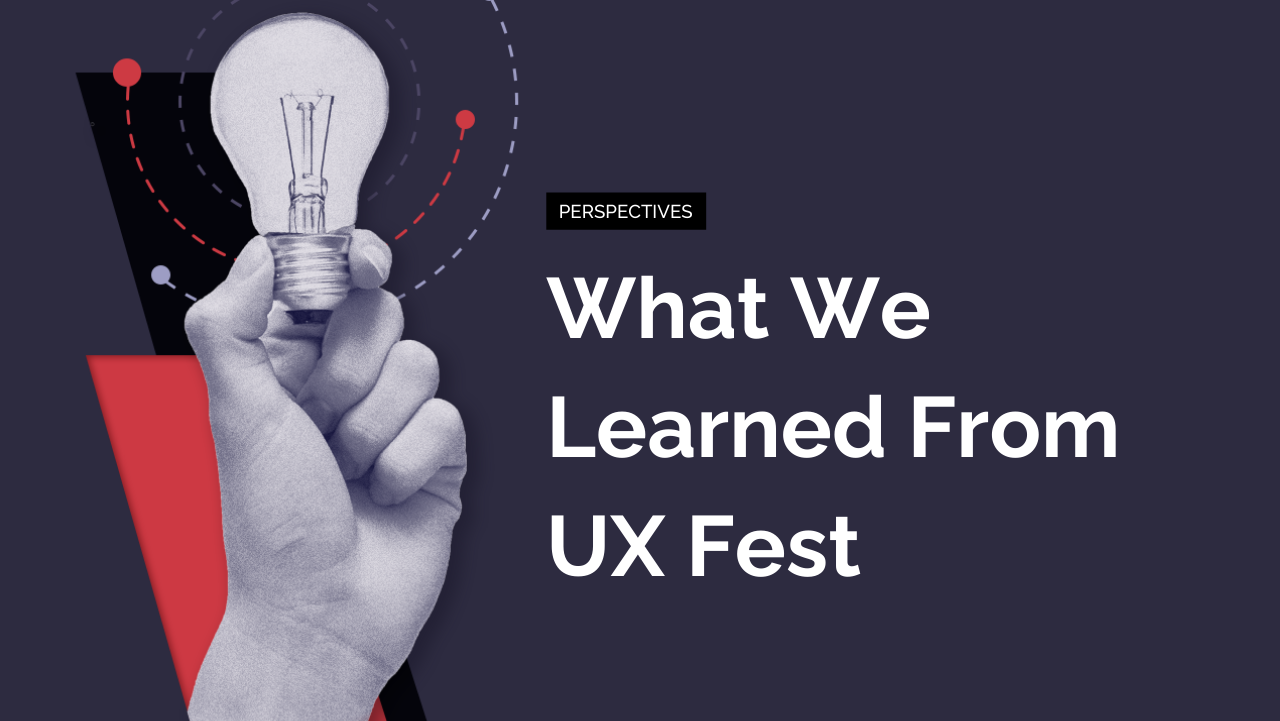UX Fest is scarcely more than two weeks in the rear view, but the memories of what we learned and what we all shared are still fresh and top of mind. For one day and through thirteen speakers, we were inspired to look beyond the technology to discuss what makes for amazing, immersive, and memorable experiences. Following are just fifteen of the things we learned at UX Fest.
#1 We don’t create anything without the support of others
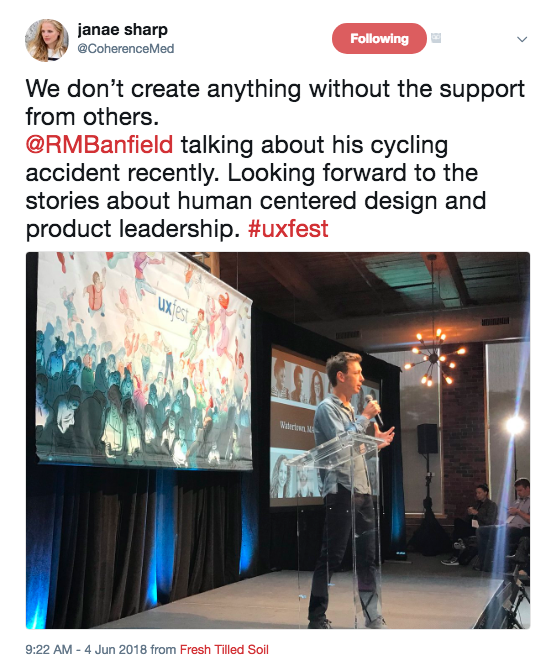
Richard Banfield kicked off the day explaining why we brought UX Fest back after a short hiatus. As in years past, UX Fest is not just about curating a list of speakers with technical or domain expertise within the UX field. It’s also about assembling people who have interesting things to say. Things that are different and unusual that bring the experience element of UX to the fore rather than just the technical or the user testing part of it.
The broader theme of UX Fest was about facing and overcoming failures and obstacles – in inspirational or tactical or strategic ways – to create something memorable and remarkable. Ultimately, this doesn’t happen without the support of others. Without teams that are centered around understanding human-centric problems more than technical problems. We aren’t creating anything without the help and support of others. And none of this happens without the presence of empathy, connection, communication, trust, and other things we often take for granted.
#2 Your brain is a very powerful piece of equipment

Olympic silver medalist Paul Wylie shared his inspiring story of resilience and challenged us all to know our purpose in life. For Paul, over 24 years of work translated into just .8 sec that could have spelled disaster. Fortunately for him, he found the mental strength to pull through and capture a spot on the podium!
Your brain is a very powerful piece of equipment.
Years later, he encountered an even bigger opponent – sudden cardiac arrest – that would require even greater mental, emotional, and physical strength to overcome.
#3 Create an environment that allows design to thrive
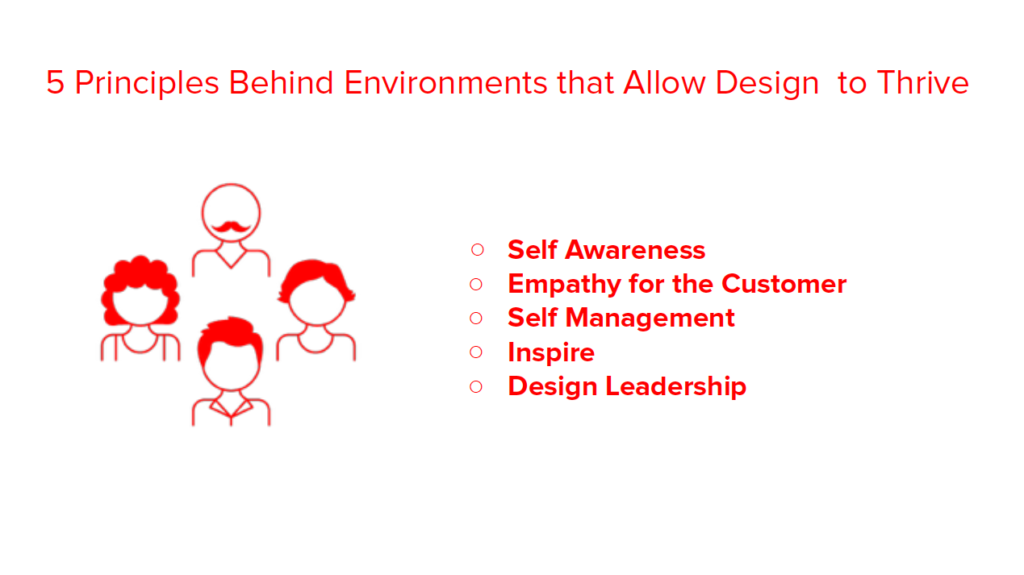
Crisis Text Line’s only designer left on Sarah Bernard’s first day. Fortunately, Sarah already knew what she was looking for when searching for great designers – those who can facilitate a conversation across multiple roles to focus on the problem and deliver a design solution that’s relevant. She knew she wanted to create an environment where designers were truly inspired. One that was guided by 5 principles:
- Principle 1 – Self Awareness. If you are not the designer, trust the designers to do their jobs.
- Principle 2 – Empathy. The #1 thing that we all have in common is that we are not looking at things from the perspective of the user. Doing user research together evens the playing field and our knowledge of the customer – among designers, engineers and product owners
- Principle 3 – Self-Management. Don’t over prescribe solutions. In exchange for self-managing, designers will come back and surprise you. Let them delight you with great solutions.
- Principle 4 – Inspire. It can be tough for business people to be inspiring to designers. Support activities that inspire your design teams.
- Principle 5 – Design Leadership. Give up leadership to others.
#4 Inspired teams solve the most important problems
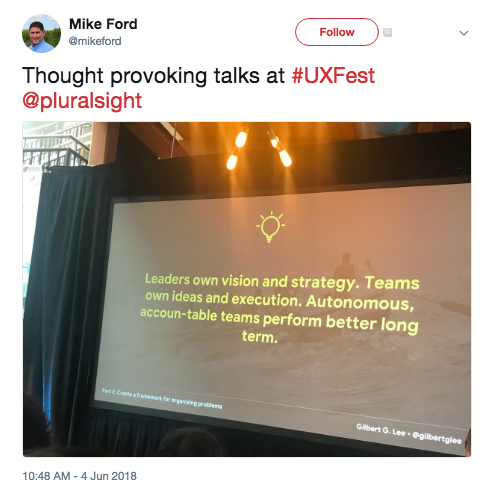
Barely two weeks prior to UX Fest, Gil Lee was on the floor of the NASDAQ celebrating Pluralsight going public. Part of their success is due to the way they approach empathy with their customers. Empathy leads to a better mission, vision, strategy, products, and team alignment.
Bias leads to blind spots.
Gil described part of Pluralsight’s path to empathy in three parts:
- Part 1 – Understand your customer’s problem space so you can focus on them rather than your products. Talk about your users’ needs where they work and where they live.
- Part 2 – Create a framework for organizing problems for your teams so you can inspire them. Inspired teams solve the most important problems.
- Part 3 – Capture problems organizationally. Feedback can be valuable and distracting. Be clear with your vision, strategy, and objectives.
#5 Create opportunities for deeper conversations
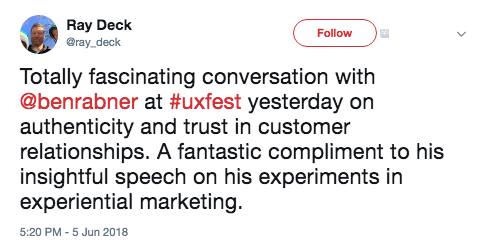
As creators of user experiences we tend to obsess over the technology, but we are really missing something incredibly powerful and even more complicated than the technology – the neurobiology and physiology of humans. Traditional B2B marketing often lacks emotion and creativity. Creating more memorable experiences can provide opportunities for deeper conversations and have a bigger impact on your bottom line.
Algorithms don’t feel, people feel.
In order to deliver more amazing customer experiences and tap into these incredibly valuable emotions, you have to be part artist, tech expert, anthropologist, and scientist. These experiences can enable your customers to spend less time in the tactical part of their brain (the executive network) and more time in the part of the brain that unlocks creativity, inspiration and innovation (the default network).
#6 Effective HPPO-wrangling is a critical skill

HPPO (Highest Paid Person’s Opinion) wrangling, also known as stakeholder management, is never easy. Part art and science, keeping executives focused on the big picture without getting too mixed up in the product is the product owner’s responsibility. How you manage up and how you defend the user experience for your product is a difficult but critical skill.
In Perry’s experience, the five most effective HPPO-wrangling tactics include:
- Get education on the agenda
- Define organization and product swim lanes
- Feed executives a regular and manageable data diet
- Create an experimentation safe space
- Speak so you can be heard
#7 Listening is the technology of transformation
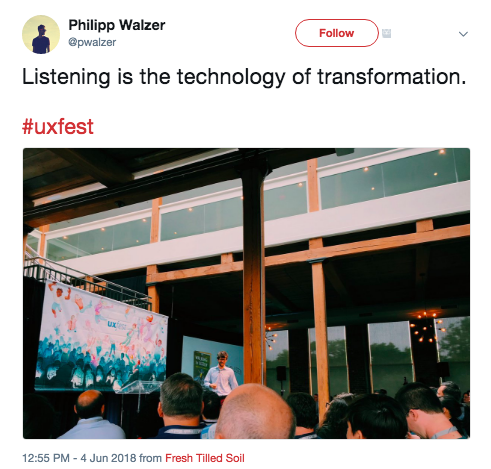
What is the experience that we can have by exposing ourselves to others’ ideas and perspectives and what others have to say when we really listen? Andrew Forsthoefel talks about extreme listening and learning how to be a true listener. Technology is a tool that makes something possible.
Listening is a technology that makes something else possible between people.
One thing he learned on his 4,000 mi walk across America was that his ability to listen sincerely and openly was a profound offering. What he eventually realized was that the simple willingness to be with someone was a gift.
#8 Starting a product company is crazy
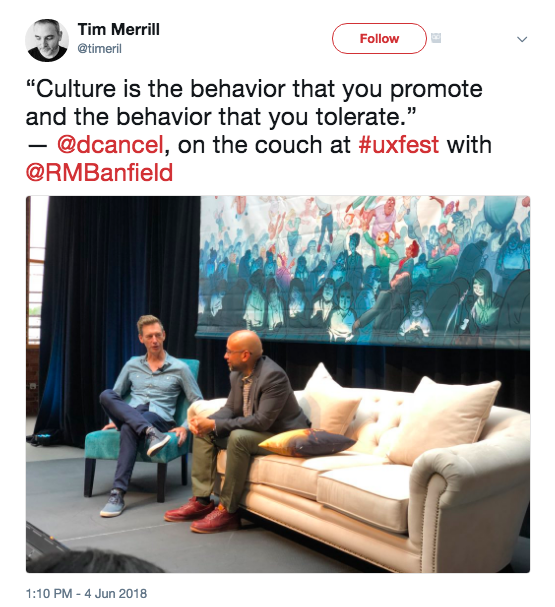
In many ways, starting a product company is crazy. The first time you start a company you can be excused because you don’t really know what you are doing or getting into. The second time you are questionable. More than two times you are certifiable. But David still believes If you are smart and have a good idea, go start a company! In the early stage there is much pain and suffering. Good thing David Cancel is a glutton for pain and suffering. The fun begins when you really begin to understand what you are doing and start to scale.
Culture is the behavior that you promote and the behavior that you tolerate.
Some nuggets we pulled from Cancel’s interrogation:
- You can’t really turn on and off caring about the details.
- Everything you design and build is wrong. Your job is to build it, get it out in the market, and figure out how wrong. Are you just a little bit wrong, or are you 100% wrong?
- Culture is just the sum of people that are present in your company. It’s not static, it changes every day.
- The role of the Chief Repeater Officer – It takes most people many reps for us to hear something. You have to constantly repeat the mission, vision, why we are here, etc.
- There is no right answer, there are just decisions and consequences
#9 Make your users heroes

Users and products are everywhere. People (especially in the room at UX Fest) are constantly evaluating your products and the experiences they deliver.
People don’t want a ¼ inch drill. They want a ¼ inch hole.
User experience doesn’t stop in the discovery phase. You aren’t done when the MVP is designed and delivered. How often do you get it right the first time? As product leaders, you have to gather feedback throughout the product life cycle. This includes talking to your customers’ customer! Otherwise you aren’t understanding the full impact of your product.
#10 We are all product people
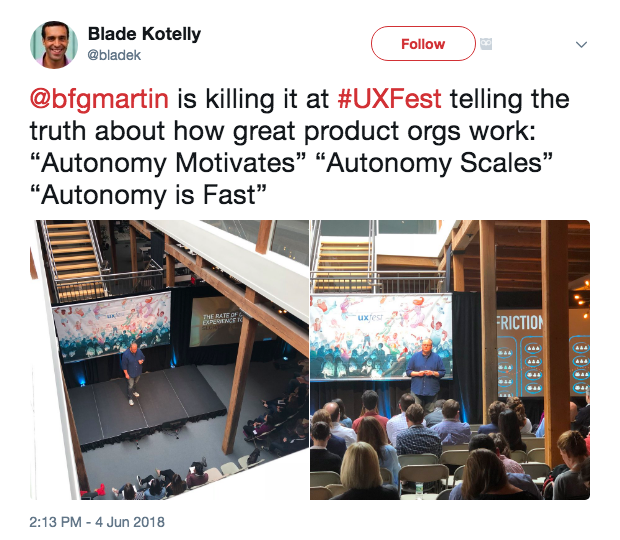
Software is eating the world – faster and faster. There are numerous examples from Uber to Airbnb to Alibaba. The world’s largest taxi company that owns no cars, the world’s largest hotel company that owns no hotels or buildings, and the world’s largest retailer with no stores and no inventory respectively. Clearly something has changed.
How do we keep up? And how do we keep building better products? We are all product people. We all exist at the intersection of business, technology, and design.
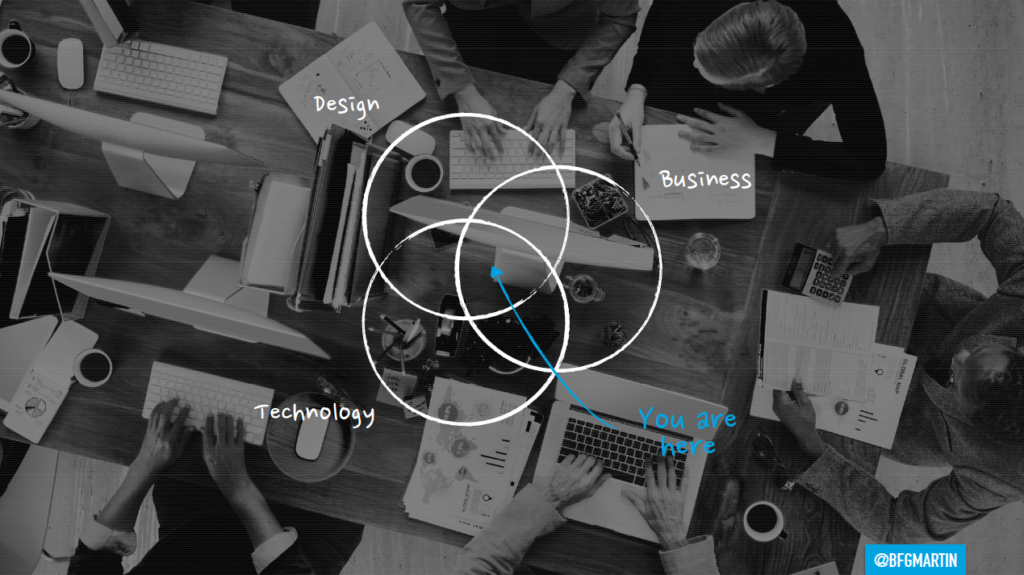
Diverse companies are 35% more likely to outperform their competition.
Ultimately, socially diverse, cross-functional, co-located teams are more innovative and better at solving complex, non-routine problems.
#11 The EHR is not solely to blame for and can help in cases of physician burnout
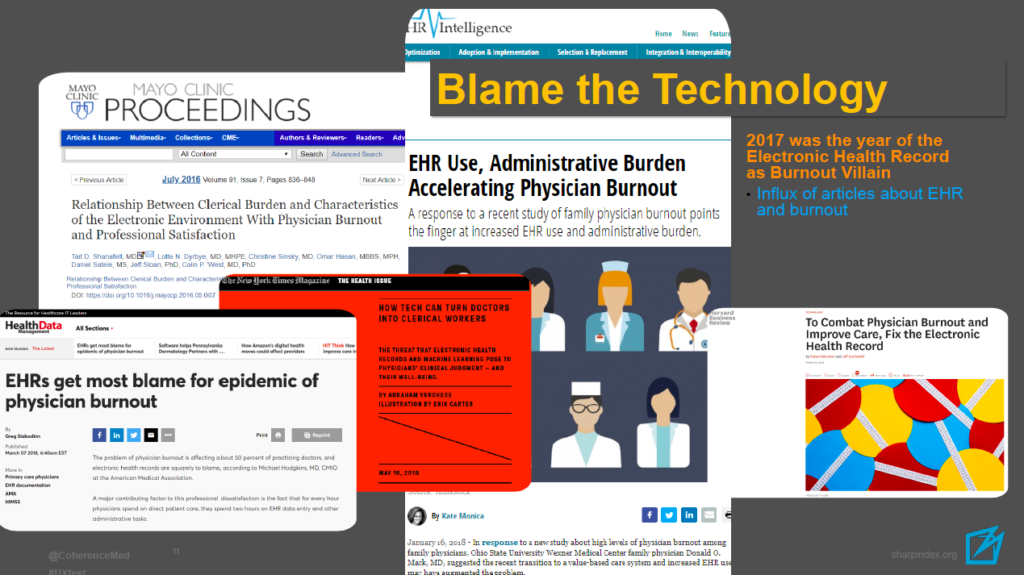
EHRs often get the blame for physician dissatisfaction – 52% of a physician’s time is spent in the EHR. This results of a feeling of lack of empowerment.
You don’t do a good job in a job you hate.
But while EHRs can be a source of misery for physicians, they are not always associated with physician dissatisfaction. Terrible tech isn’t’ necessarily going to lead to dissatisfaction. The number one factor in whether or not you will recover from depression is social support. Your community. The Sharp Index is creating tools that can aid in the detection of burnout by alerting physicians and their support networks to potential burnout while providing them with resources and treatment.
#12 We are uniquely equipped to build inclusive cultures
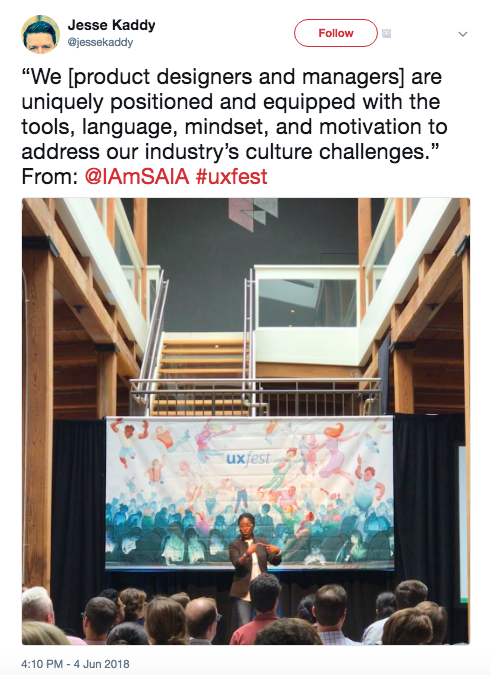
Adaora is “a walking edge case.” She started her discussion by declaring we she was NOT going to talk about:
- Guilting us into doing better
- The business case for diversity
- Making a moral argument about reaching into other groups when building a team
- She does not have the answers about how we should build a culture
Design for inclusion, build for scale.
In product we are used to filling multiple roles and holding multiple truths. We solve harder problems everyday; Culture is a product to be envisioned and nurtured — and we are ALL responsible for doing so.
#13 Take a radical approach to building vision-driven products
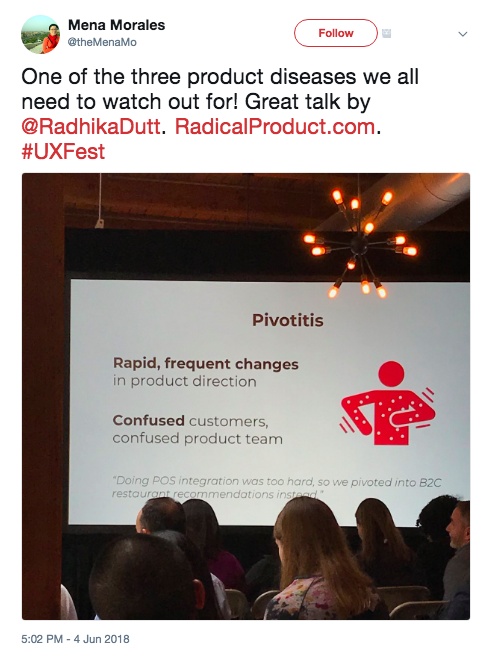
Product thinking is experiencing a global movement. There are three underlying concepts behind this big idea:
- Everyone is in a product organization (whether we realize it or not)
- Every one of us can own the product vision to build products with purpose
- Until now the path to building vision-driven products wasn’t clear
Thankfully, this is all changing now through a movement called Radical Product. The Radical Product approach seeks to help product leaders and owners avoid some of the most common product diseases that happen in the absence of a clear product vision and strategy.
#14 Technology goes hand-in-hand with social progress
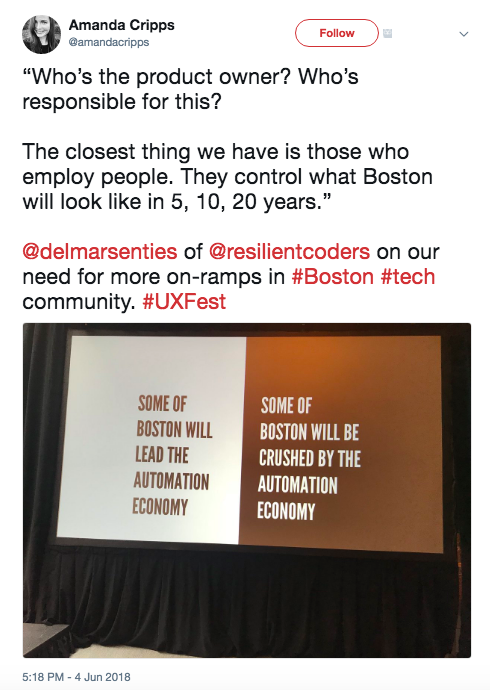
David Delmar founded Resilient Coders in 2014 with the idea that technology goes hand-in-hand with social progress. And in that sense, David says coding, is not the message, it’s the megaphone. “If the day after tomorrow, what’s employable in this city is something else, we’ll do that, but for now it’s coding, so we are Resilient Coders, because that’s the way that we are economically empowering the communities in the city.”
Technology is just the name we give to the tools that we build to advance the standard of living for everybody.
David loves technology because of what it means for the city of Boston. The tech economy in the city of Boston is a product.
#15 You, the audience, make UX Fest
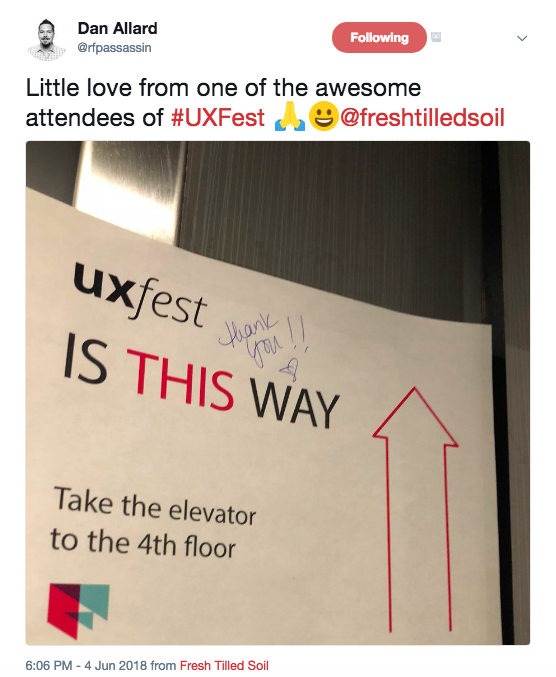
Once again, you, the audience, were what contributed most to the success of UX Fest. Each of you contributed to the richness of the day’s presentations and learnings. UX Fest again brought together people from different disciplines within the organization to have a conversation about what’s important to their particular project, product, role, or business.
The diversity of roles present at UX Fest gives us a new understanding of what UX means to different people and what it can be with a new perspective. It provides us with an opportunity to learn from one another and increases the likelihood of making beautiful products and experiences.
Thank you for coming to UX Fest 2018!
